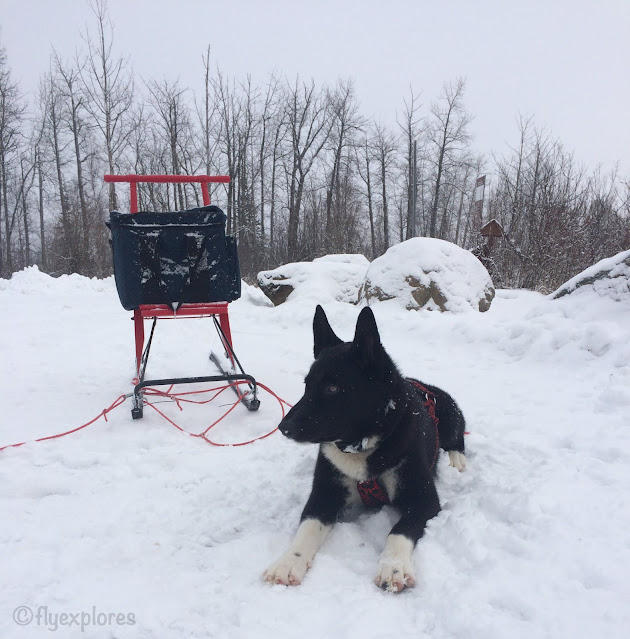Hey Tribe,
Snow seems to be sticking to the ground now and the night temperatures are in the single digits (F), so I think winter has truly arrived.
Time to bring the kicksled out of its summer slumber! We don't yet have enough snow near the house to begin using the kicksled, but I believe it won't be long until we have decent snow cover and frozen surfaces on which to play. I want to give the sled a once or twice over, to make sure we are all prepped and ready to run, so I thought now would be the perfect time to fill you in on how we have it set up for the dogs to pull. If you need some background about the kicksled, you can read about
our purchase and then come back to finish reading this post!
Okay, where shall I begin? As savvy readers, you know that my Esla Kicksled is meant to be leg powered, not dog powered, but I have dogs, so dog power is what I wanted.
To set the sled up to be pulled by dogs some additional equipment was needed.
Eye bolts were added to either side of the brush bar: it was easy to remove the regular bolts and replace them with the eye bolts. They hold the rope in place.
The rope (called the bridle) is attached to the stanchions, which is where the sled will be pulled - attaching the bridle to the stanchions will also help with steering, since this is where the sled flexes for that. The rope is then fed through the eye bolts - or more exact, rope is attached to one side, fed through the eye bolts and then attached to the other side.
Then, the gangline is attached to the bridle. Mine is about 8 feet in length (including the stuff below).
I wanted something dual purpose at this point: line to attach the dogs to the gangline that could also serve as a leash, in case I wanted to leave the sled and take the dogs with me while we are out. So I have two "leashes" that attach to a locking carabiner at the end of the gangline.
Having a neckline is important too, though not necessary if your dogs are well trained, and not technically part of the kicksled setup, but here I am writing about it anyway... It is a short, homemade, line with clasps on either side that connect to each dog's collar. This short line keeps the dogs together, so one doesn't zig while the other zags. I keep fiddling with the neckline length and think I have found a good length for how my dogs run together.
 |
Fly offered to include her foot in the photo for scale - she's so helpful.
|
Another nonessential, but incredibly handy item, is a basket or container to attach to the kicksled's seat. Mine is soft-sided, so it won't scratch the lovely birch paint. I put emergency items in there, as well as a few items I might need while out adventuring (snacks). It is such a useful place to toss my gloves or hat when I get too hot and I don't have to worry about losing them.
So, that's the setup.
Now, the beginning runs:
While waiting for our kicksled to arrive, I worked to teach the dogs the commands we would use. There are a lot of internet sources out there: I found the blog
All Dogs Are Smart and their videos to be extremely helpful.
Initially, our runs occurred along a mile straight bit of dead end, gravel (now snowy) road that folks primarily use to run their dogs. I wanted to practice using the sled and working the dogs at an easily accessible location, in case things went awry. Things tend to get, um, hairy, when my dogs are involved. However, our first few runs went surprisingly well and the dogs easily caught on to what we were doing. Rex wanted to stop and pee on shrubs every 15 feet or so and Fly wanted to cut off the road to sniff something in the bushes, but I'd growl at them, give the 'Pull' command, and they'd run again. The sled is decently light and maneuverable, so it was easy to stop the trotting dogs from dragging me into the bushes or off the road.

Our second evening out they stopped fewer times; the third evening out they stopped even less, but we encountered other dogs on the road and the KBDs went into a barking, growling, frothing frenzy. That was unpleasant. I managed to stop them by flopping to the ground and using my body as dead weight to slow the beasts to a stop in order to get them under control. Clearly we need to work on ignoring and passing other dogs.
Then, when we I had built up some sledding confidence, we ran down a similarly used road, but with curves. I would call out directions (Gee and Haw) as we took the curves, even though they were running that way anyway. Never hurts to reinforce directions. The road was snowy and packed smooth and we were fast. The dogs ran and ran.
Here's a video of that run:
After that evening run, I knew we were ready to hit the trails! We had a lot of fun last winter with our kicklsed and I can't wait to get back on those runners and find new trails.



























